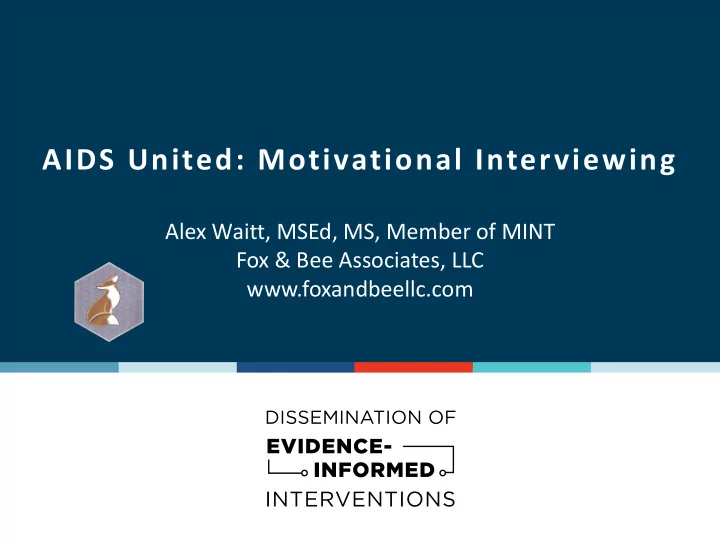

AIDS United: Motivational Interviewing Alex Waitt, MSEd, MS, Member of MINT Fox & Bee Associates, LLC www.foxandbeellc.com
Objectives • Quick Overview of MI • Review Reflective Listening – Exercise • Review change talk & sustain talk – Exercise • Putting it all together
Overview of MI • Motivational Interviewing is a client-centered, directive method for enhancing intrinsic motivation to change by exploring and resolving ambivalence Ambivalence is a conflicted state of favoring change and supporting status quo • • Help client get “unstuck” from ambivalent feelings • Exploration of client’s personal reasons for making a change BRINGING THE CLIENT CLOSER TO WHO THEY WANT TO BE FROM WHO THEY ARE RIGHT NOW Who I Who I am Who I am Who I Want Want to Be I am to Be
Theory & Principles • Self Perception Theory: How a person views him or her self impacts their behavior. • Self Determination Theory: How a person talks about him of her self impacts their behavior. • 3 principles: – People want to be their best self. – People already have what they need to be that best self. – Your job is to simply evoke that best self.
Refresher… The Four Processes of MI
OARS – Open ended questions (questions that invite elaboration) – Affirmations (reinforce client’s strengths) – Reflective listening (clarifying statements that illustrate underlying meaning) – Summarizing (links material that has been discussed to establish common ground)
Let’s Review Reflective Listening • Remember there are 3 types of reflective statements. – Simple: Literally using the client’s words and giving it back to them. – Complex: Adds meaning, value or emotion to the client’s words. – Double-Sided: highlights discrepancy between client’s words/values and actions.
Reflective Listening in Pairs • Handout
The Keys to Readiness Readiness Importance Confidence Rosengren , David. "Building Practitioner Skills" Guilford press 2009, page 255
How do we Recognize Change Talk? **The Key is to Listen for Language that Signals Movement Towards Change** Preparatory Change Talk (Pre-) Contemplation (Engagement/Persuasion) D (DESIRE): want, wish, like A (ABILITY): can, could, able R (REASON): specific reason for change N (NEED): need to, have to, must, important, etc… (without stating specific reason) MobilizingChangeTalk ---- Commitment Language Preparation & Action (Late Persuasion/Active TX) C (COMMITMENT): will, intend to, going to A (ACTIVATION): ready to, willing to (without specific commitment) T (TAKING STEPS): reporting recent specific action (steps) towards change
Identify the Statement… • Identify each statement as Change talk or Sustain talk. If it is change talk, what type of change talk is it? • These medications make me sick. • I’m not doing this crap anymore. • If I only knew how… • I don’t think you actually care. • I’m ready to give up.
Identify the Statement... • I don’t think my drinking is a problem. • My friends think it’s ok so what’s the big deal? • I’m not too hopeful. • If I thought there was a chance I would try. • I’ll think it over. • I’ve lost so much. • I wish I could have less stress in my life.
Reflections can be… • STABALIZING Or… • Forward Moving
“I’m sick and tired of everyone being on my case.” • Stabilizing: “Everyone is on your case.” • Forward Moving: “You’re sick and tired and ready for a change.”
“I’m not sure what to do.” • Stabilizing: “You’re not sure.” • Forward Moving: “You’re not sure and you want to make the right decision.”
Reflective Listening Part 2 • Baseball Exercise
Eliciting Change Talk Exercise: (Client) Something about yourself that you – Want to change – Need to change – Should change – Have been thinking about changing BUT YOU HAVEN’T CHANGED YET i.e.- something you’re ambivalent about
Let’s put it all together • Pair up. One of you will play the role of practitioner and the other the role of client. • As the client, think of a change that you actually want to make but haven’t done so yet. Use this to guide your role play. • As the practitioner, try to help the client move closer to making a decision regarding their change. Use the SPIRIT of MI and use your OARS to help create Forward Movement.
Switch Roles • Pair up. One of you will play the role of practitioner and the other the role of client. • As the client, think of a change that you actually want to make but haven’t done so yet. Use this to guide your role play. • As the practitioner, try to help the client move closer to making a decision regarding their change. Use the SPIRIT of MI and use your OARS to help create Forward Movement.
Thank You! Please feel free to send me emails, ask questions, share stories, etc. alexwaitt@foxandbeellc.com
Recommend
More recommend